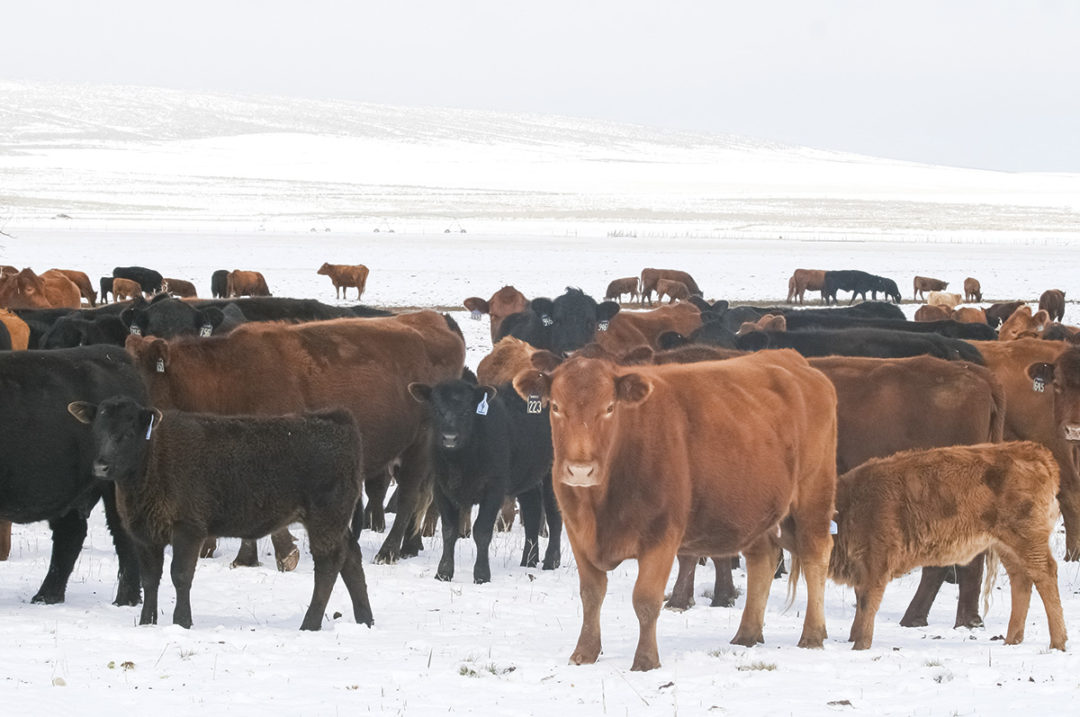The winter months are in full swing, and calving is underway on many operations. While it’s exciting to see the fruits of your genetics come into the world, the winter months can take a toll on your sleep, stress and energy levels. Short days and long winter nights are exhausting and demanding on cattle producers. However, keep in mind that your cows are experiencing at least equal levels of stress. The nutritional demands of the growing fetus during the final stages of gestation add to energy needs for the cow as she’s preparing for parturition and colostrum production. Throw in some cold stress, and you add one huge hand to the tug-of-war for your herd’s nutritional requirements.
The required plane of nutrition is at its highest as we speak, and the last thing we want our cows to do is consume a diet below their nutritional requirements and start losing weight. The implications of thin cows at calving are well established for both her and her calf, but how much extra strain is the cold weather putting on her nutritional needs? Cows are hardy and can produce their own internal heat through rumen fermentation to stay warm during cold stretches. It’s a lot like running your shop heater. The monthly energy bill for your cattle will increase during the coldest times of the year.
A cow’s lower critical temperature (LCT) is the temperature at which maintenance requirements increase to the point where animal performance begins to be negatively affected. There are several factors that influence a cow’s LCT, including breed type, adaptation to the environment and so on. Slick-haired cattle in the South can experience some degree of cold stress when the temperature is in the upper 50s. Alternatively, cattle with a dry, full winter coat in the North can withstand cold temperatures as low as 18ºF. Don’t forget the wind factor, too. For every mile-per-hour increase in wind speed, subtract from the ambient temperature to get the true wind chill factor your cows will thermoregulate against. If you can’t provide shelter from wind and snow, be prepared to intervene with supplemental nutrition.
A typical rule of thumb is that for every degree below their LCT, cows will require 1% more energy in their diet just for maintenance. How people increase energy intake depends on their resources and capabilities. A common practice is to supply more hay to the herd. This is a good management strategy in some cases, especially if you’ve saved back your best hay for these nutritional periods. Cattle can consume a few extra pounds of high-quality hay and meet their elevated maintenance requirements in moderate winter conditions.
However, it’s important to remember when forages are fed, physical fill is the limiting factor for intake. This could be problematic in severe cold conditions because cattle may not be able to physically consume enough energy through the extra supplied hay because they are “full.” High-quality hay is expensive, but feeding cows that are losing weight because of physical fill is just as costly. Consider feed additives in your TMR or mineral program to boost the digestibility of your cow diets and unlock more energy during periods of cold stress. I recommend a research-proven prebiotic that stimulates fiber-digesting bacteria as well as rumen fungi. These fungi in the rumen are responsible for physical degradation of cell wall components as well as rumen enzymatic production. Stimulation of the rumen fungi improves NDF digestibility, so intake is not limited to the constraints of rumen fill.
Another strategy to ensure cows meet their elevated energy demands is to increase the energy density of the diet with concentrates like corn, dried distillers grains (DDGs) and so on. This method ensures that cattle can consume enough extra metabolizable energy without rumen fill being a constraint. Starches in cereal grains are fermented to propionate, which is a precursor to glucose and is more efficiently utilized as an immediate source of energy than acetate from forages. However, feeding grains to cows that are nutritionally adapted to high-forage diets can run the risk of subclinical acidotic events or other digestive upsets. If you feed more than 2 to 3 pounds of corn per head, you run the risk of mild acidosis, impacting fiber digestion in the rumen. Supplemental grains can help with increasing energy density of the total diet. However, it’s key to understand that moderation is important in ensuring proper elevated levels of energy are provided to the cow without compromising overall rumen health and fiber digestion.
All supplemental strategies have a cost, so one should consider feed additives to improve feed utilization, especially during these periods of cold weather. Prebiotics can help stimulate the rumen microbiome to improve digestion and energy and protein utilization. Unlocking more nutrition from within allows producers to get more out of their forages and alleviate energy intake limitations due to physical fill. In fact, a volatile fatty acid (VFA) boost of 16% from daily feeding of prebiotics is nutritionally equivalent to the amount of energy you would get from feeding a pound of DDGs. This doesn’t even include the benefits of improved gut health without any additional labor or capital. Considering the cost of a pound of co-products in today’s market, an increase in feed costs of 3 to 4 cents per head daily for the prebiotic may make more financial sense than ordering your next truckload of DDGs.
Winter is exciting and exhausting all at once. Cows are a lot tougher than we are in the cold weather, but now is a critical time to pay attention to the energetic strains cold stress can have on your cows at their highest nutritional needs. There are many ways to supplement your daily feeding program, but make sure the strategy you choose uses your best available resources to provide the correct nutrition for the best return on your investment. Feeding hay and supplementing grains can both work well. Keep in mind each has limitations and a cost. It may be time to think outside the box. Incorporating feed additives into your daily program can be a valuable tool to give your herd when the winter weather doesn’t cooperate.











